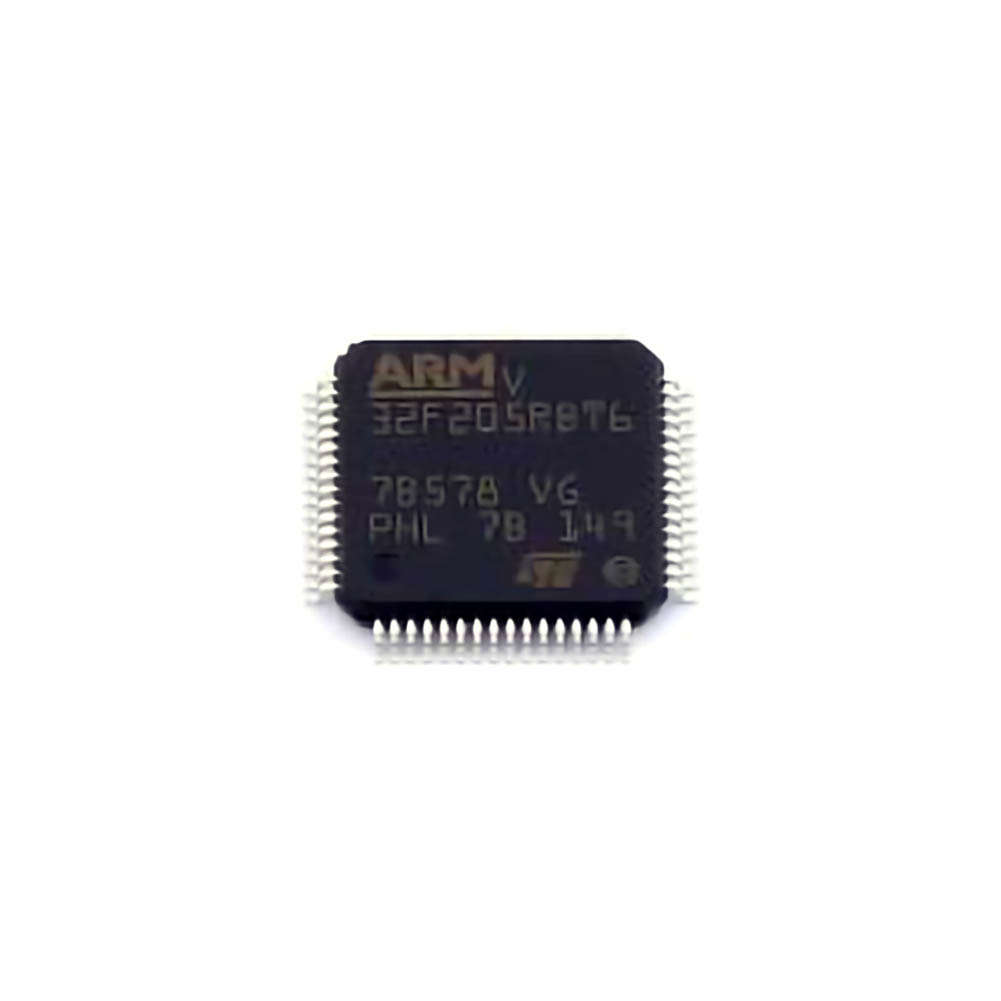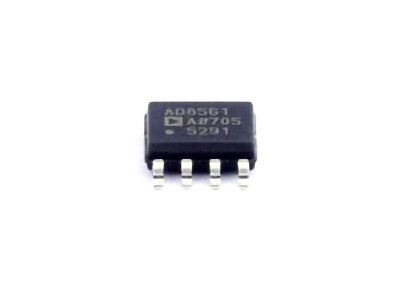
Introduction to STM32F205RBT6 and its Applications
The STM32F205RBT6 is part of the STM32 family of 32-bit microcontrollers from STMicroelectronics. Built on the ARM Cortex-M3 architecture, this microcontroller offers high performance, low Power consumption, and a wide range of connectivity options, making it a versatile choice for embedded systems development. It is particularly popular in industrial control systems, consumer electronics, robotics, automotive applications, and IoT devices.
Features of STM32F205RBT6
Before diving into optimization, it’s essential to understand the key features that make the STM32F205RBT6 suitable for a variety of embedded applications:
Core and Performance:
The STM32F205RBT6 is powered by an ARM Cortex-M3 core, operating at a maximum frequency of 120 MHz. This allows for a good balance between processing power and energy efficiency, making it suitable for real-time and computationally-intensive tasks.
Memory and Peripherals:
This MCU comes with 512KB of Flash memory and 96KB of SRAM. The large memory capacity supports complex applications while the abundance of peripheral interface s like UART, SPI, I2C, and USB makes it flexible for a range of connectivity options.
Timers and Interrupts:
The STM32F205RBT6 features advanced timers and interrupt management, which are crucial for time-sensitive applications. Its wide range of timers allows for precise time control in applications such as motor control, signal generation, and audio processing.
Low Power Consumption:
With several low-power modes, including Sleep and Stop modes, the STM32F205RBT6 is designed for energy-efficient embedded solutions that require long battery life or continuous operation.
Rich Development Ecosystem:
The MCU is supported by a comprehensive ecosystem of development tools, including STM32CubeMX for configuration, STM32CubeIDE for development, and a vast range of libraries and middleware for different applications.
Applications of STM32F205RBT6
The STM32F205RBT6 microcontroller is ideal for applications where a high level of processing power and low power consumption are required. Some of its prominent use cases include:
Industrial Control Systems:
In industries such as automation, robotics, and manufacturing, STM32F205RBT6 is used to control machinery, monitor sensors, and handle communication protocols like Modbus or CAN bus.
Consumer Electronics:
Many embedded devices like smart home appliances, wearables, and health monitoring devices rely on STM32F205RBT6 for its ability to manage multiple interfaces and power-efficient performance.
Automotive Applications:
The microcontroller’s ability to handle real-time tasks, such as sensor data processing and motor control, makes it suitable for automotive applications, including electric vehicle (EV) charging stations and engine control systems.
Internet of Things (IoT):
IoT applications that require wireless connectivity, such as smart agriculture and remote monitoring systems, also benefit from the STM32F205RBT6’s extensive set of communication peripherals.
Code Optimization Techniques for STM32F205RBT6
While hardware features such as processing power and memory are important, code optimization plays a crucial role in maximizing the performance of embedded systems. For embedded developers, optimizing code ensures faster execution, reduced power consumption, and more efficient use of system resources.
1. Minimizing Interrupt Latency
One of the key factors for optimizing embedded applications is reducing interrupt latency. STM32F205RBT6 supports various interrupt priorities, which allow developers to prioritize critical tasks and reduce delays in processing. Effective interrupt management ensures that high-priority interrupts are handled promptly, while less critical tasks are deferred.
Tips for reducing interrupt latency:
Use Direct Memory Access (DMA): DMA can offload data transfer tasks from the CPU, enabling faster and more efficient handling of interrupts, particularly for peripherals like ADCs or UARTs .
Set Appropriate Priority Levels: STM32F205RBT6 supports configurable priority levels for interrupts. Assigning higher priority to more critical tasks helps reduce response time for those tasks.
2. Efficient Use of Memory and Peripheral Resources
Memory management is a crucial aspect of embedded systems optimization. STM32F205RBT6 provides ample memory (512KB Flash and 96KB SRAM), but developers need to be mindful of how they use it to avoid inefficient memory utilization and memory leaks.
Optimize Data Structures: Use memory-efficient data structures, such as bitfields for storing Boolean flags or union types for memory-sharing between different types of data. This reduces memory overhead and minimizes the impact on system performance.
Use Peripheral Buffers : Many peripherals in STM32F205RBT6 support direct memory access (DMA) for data transfer, which can be used to minimize CPU intervention and reduce memory usage. Using DMA buffers effectively will free up valuable system resources for other tasks.
Enable Memory Protection Unit (MPU): The STM32F205RBT6 features a Memory Protection Unit (MPU), which ensures that code and data sections are segregated to prevent accidental overwrites. Proper use of the MPU can enhance the stability and security of the application.
3. Optimizing Power Consumption
One of the major advantages of the STM32F205RBT6 is its low power modes. To optimize power consumption, developers must ensure the device enters the most appropriate power mode during idle times.
Use Sleep Mode: In low-demand situations, the microcontroller can be put into Sleep mode where only essential peripherals remain active. This significantly reduces power consumption while maintaining responsiveness.
Configure Dynamic Voltage Scaling (DVS): For applications that require high performance during certain phases (e.g., data processing or communication), enabling DVS can help dynamically adjust the operating voltage and frequency to balance performance and power consumption.
Optimize Peripheral Clock ing: Disable unnecessary peripherals or clock domains during idle periods. STM32F205RBT6 allows individual peripherals to be turned off, which can further reduce power consumption.
4. Code Optimization Techniques for Faster Execution
To maximize the performance of your application, code optimization techniques must be employed to ensure efficient execution.
Use Efficient Algorithms: When dealing with mathematical calculations or signal processing tasks, always consider the computational complexity of algorithms. For example, using lookup tables for trigonometric functions or pre-computed values for frequently used calculations can drastically speed up execution.
Avoid Heavy Floating Point Operations: The ARM Cortex-M3 core in the STM32F205RBT6 lacks hardware support for floating-point operations, which makes them relatively slow. Whenever possible, use fixed-point arithmetic or optimize floating-point calculations to reduce the execution time.
Optimize Compiler Settings: Utilize optimization flags during compilation to improve the performance of the generated code. Compiler optimizations such as loop unrolling and inlining of functions can help reduce the size of the code and make it run faster.
Efficient Use of System Timers: Leverage the advanced timers available in STM32F205RBT6 for tasks such as PWM signal generation or time-based event scheduling. Efficient use of timers can offload tasks from the main processor and improve overall system performance.
5. Debugging and Profiling for Performance Bottlenecks
Optimization isn’t just about applying generic techniques; it’s about identifying where your application can be improved. Use debugging and profiling tools to pinpoint performance bottlenecks.
Use STM32CubeIDE’s Built-In Debugger: The STM32CubeIDE offers a powerful debugging environment that can help trace code execution, inspect memory usage, and visualize peripheral interactions.
Profiling with SystemView: Tools like SEGGER’s SystemView can help you visualize task timing, interrupt latency, and function call frequencies. This detailed insight helps in identifying critical sections of the code that require optimization.
Conclusion
The STM32F205RBT6 is a powerful and flexible microcontroller that can be used in a wide variety of embedded system applications. However, to fully exploit its potential, developers must focus on code and system optimizations. Whether it’s managing interrupts efficiently, reducing power consumption, or improving memory utilization, each optimization step contributes to creating robust and high-performance embedded systems. By following the strategies outlined in this article, developers can maximize the capabilities of the STM32F205RBT6 and ensure their embedded projects meet the desired performance, reliability, and power efficiency standards.
If you are looking for more information on commonly used Electronic Components Models or about Electronic Components Product Catalog datasheets, compile all purchasing and CAD information into one place.


